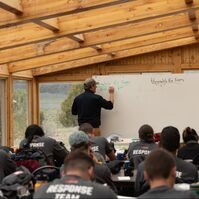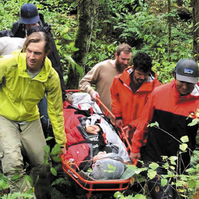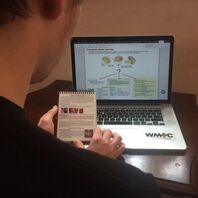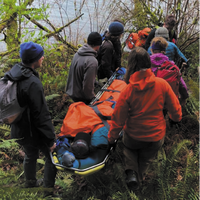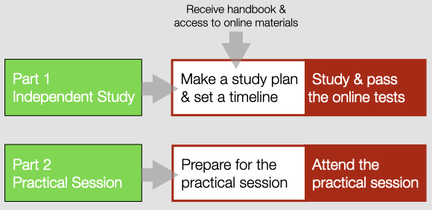|
Standard Courses
Standard courses are taught entirely in-person. We deliver lectures using a combination of whiteboard, video, digital slides and animations, and injury photos. Over 50% of each course is skill labs, case studies and simulations. If you learn best by having daily in-person interaction with an instructor, a standard course might be a great choice for you. |
Hybrid Courses
Hybrid courses have two parts that must be completed within one year. Lecture material is learned independently at students' own pace then reinforced by testing (Part 1). Students then attend an in-person practical session (Part 2) where they apply what they've learned to simulations, case studies, and skill labs. Hybrid courses maximize students' time away from home and work. Learn more. |
Both formats cover the same material using slightly different pedagogy. Learn more about our pedagogy and delivery strategies. For some people, the primary decision-making factor is time away from home or work. For others, it has to do with their learning style. For others still, its location and dates. For most, it's a combination. Tuition for both courses includes our weather-proof Wilderness Medicine Handbook and our Patient SOAP Notes. This blog article may help you with your decision: Is a Hybrid Course in Wilderness Medicine Right for You?
Course Type |
Standard Course Length |
Part 2 Hybrid Practical Session Length |
Wilderness First Aid (WFA) |
3 days/26 hours/± 1 evening session* |
2 days/18 hours/1-2 evening sessions* |
Wilderness Advanced First Aid (WAFA) |
5 days/45 hours |
3 days/30 hours/1 evening session |
Wilderness First Responder (WFR) |
9 days/80 hours |
5 days/50 hours/2 evening sessions |
Wilderness EMT (WEMT) |
NA |
5 days/50 hours/2 evening sessions |
WFR & WEMT Recertification (Recert) |
3 days/28 hours |
2 days/20 hours/1 evening session |
* WFA courses that include CPR certification have a two-hour evening skill and testing session. Refer to the specific course syllabus.
Factors to consider when choosing a course format, sponsor and site:
- If you learn best when you have access to an instructor, or are easily frustrated by technology, choose a standard course. Remember: You won't have access to an instructor during the Part 1 independent study portion of a hybrid course.
- If you prefer learning on your own and have access to a the internet and a computer or tablet, consider a hybrid course. (We don't recommend using a smartphone to access the course websites.)
- If you like studying with other people in the evenings, choose a standard course with a camping or lodging option, especially if it includes a meal plan.
- Travel time and expenses: It's typically much more affordable to select a course you can commute to daily. Remember that both course types have long days. Consider the ease of your commute and your energy. Walking or biking will give you some exercise but require additional time. If you live with others, will you be able to study in the evenings?
- Do you want to get away from home and work for a while? Do you have time to explore the area before the course or after? Some sponsors offer camping or lodging options in beautiful places.
- You will learn the most during simulations, especially if you are taking a WFR or WEMT course. Some course sites have easy access to realistic and challenging terrain: mountains, rivers, lakes, ocean, snow, desert canyons, etc. Consider choosing a course based on the available simulation terrain. If possible, choose a course with simulations sites that match the topography you regularly encounter during your trips.
- IMPORTANT: When comparing the number of days in a practical session to the number of days in a standard course, the online portion of a hybrid course will typically take MORE time, sometimes significantly more time, to complete than the difference in days may seem to indicate. For example, our standard WFA course is three days or roughly 26 hours (28 hours if Wilderness CPR/AED certification is included) while the in-person practical session of a hybrid WFA is two days or 18 hours (20 hours if Wilderness CPR/AED certification is included). A student completely new to first aid or pre-hospital medicine who registers for a hybrid WFA course can expect to spend 10+ hours studying in order to pass the online exams. If the student wants to fully grasp the material, they could spend 15 hours or more preparing for the practical session. In general, students can gain more complete mastery of the didactic material through a hybrid course than a standard course if they allocate the time to understand the material. The key to success in a hybrid course is for students to plan for significantly more study time and to stick to a predetermined study schedule. We have recommended study plans on each hybrid course website.
Hybrid Courses
Our hybrid courses are divided into two distinct parts, you must complete both parts within a year to receive certification.
|
Part 1
Independent Study Learn the wilderness medicine curriculum online and at your own pace through multimedia presentations, the Wilderness Medicine Handbook, case studies, SOAP Notes, and testing. The Independent Study section provides the foundation for the Practical Session and is presented entirely online with minimal or no instructor contact. Students can complete the Independent Study from wherever they can access the course website. The Independent Study section requires a high degree of initiative and self-direction. Students who prefer to learn completely under the direction of an instructor may be challenged to move through Independent Study effectively. The Independent Study section and the Practical Session both contain technical terminology as well as complex explanations of concepts. Students who have learning challenges or aren't fluent in the language that the course is offered may find navigating the online curriculum difficult. Please contact the WMTC office before you register for a hybrid course if this might be a concern for you. |
Part 2
Practical Session The Practical Session is facilitated by expert instructors who clarify and reinforce the Independent Study information with skill labs, simulations, and case study reviews. Because there may be a large gap between the time you finish Part 1 and begin Part 2, you may want to take an online Review test before the start of your practical session. The review test is designed to refresh key concepts learned during the Independent Study. You can also review your original tests and you will still have access to the course website. |
Hybrid course students have options for how they register and move through a course. In most cases, we recommend registering for both parts of a hybrid course at the same time by finding a course. Below are a few reasons why you might consider registering for the Part 1 online session now and separately register for the Part 2 practical session later.
If you need to be certified by a certain date, we recommend taking a look at the Part 2 schedule to find a course that works for you. We add Part 2 practical sessions to the schedule often so if you don't see a Part 2 practical session that meets your needs, please contact the WMTC office — we might know of a practical session that is still in the contracting sage and not posted yet.
- You'd like to get started on Part 1 and there currently aren't any Part 2 practical sessions that fit your schedule.
- You have time to complete Part 1 now, but are unsure that you will have time later.
- You're unsure about taking Part 2.
If you need to be certified by a certain date, we recommend taking a look at the Part 2 schedule to find a course that works for you. We add Part 2 practical sessions to the schedule often so if you don't see a Part 2 practical session that meets your needs, please contact the WMTC office — we might know of a practical session that is still in the contracting sage and not posted yet.

